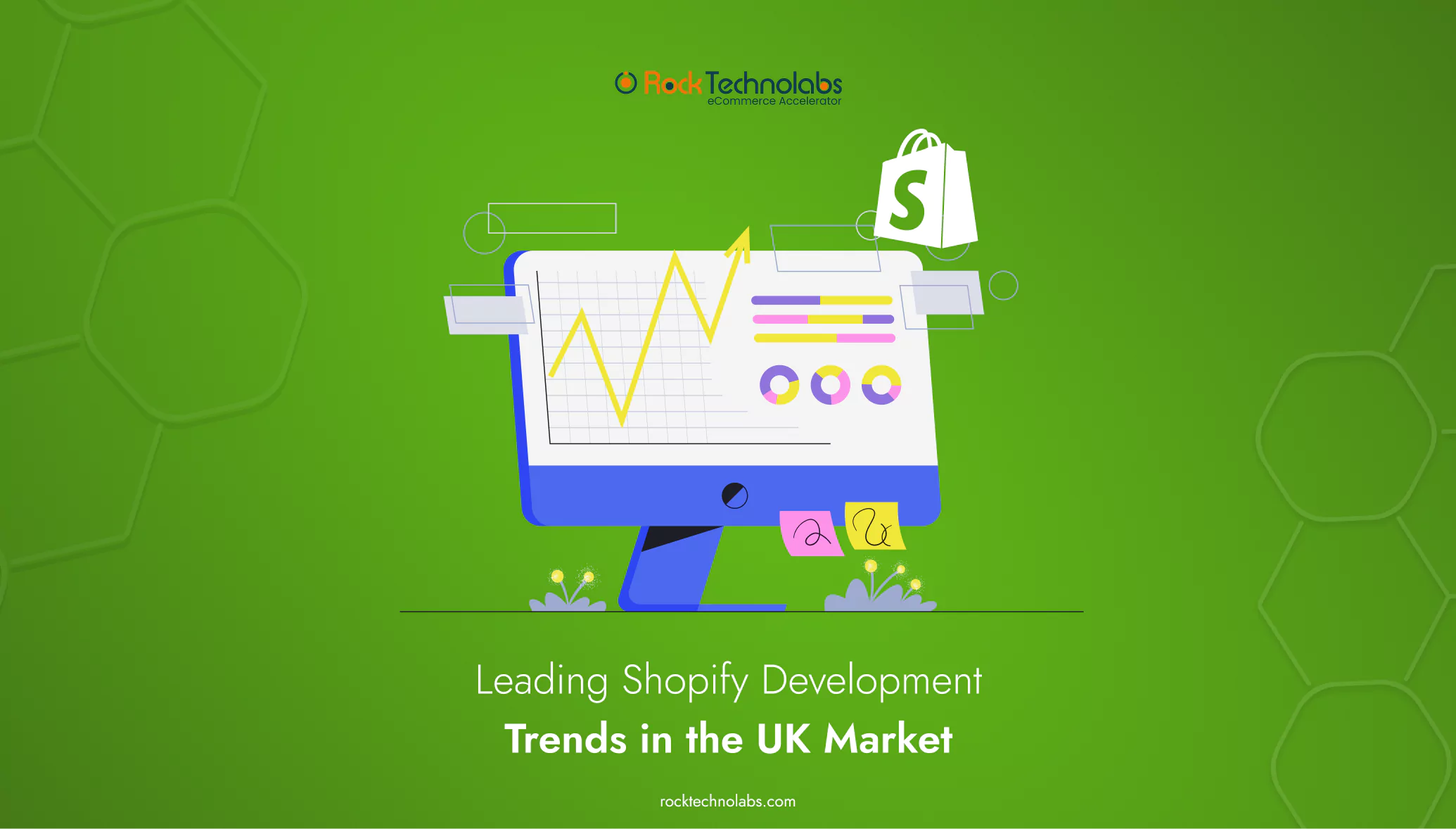Leading Shopify Development Trends in the UK Market

Forget everything you knew about eCommerce five years ago. In the UK, Shopify is rewriting the rules. It’s not just about selling online anymore—it’s about creating immersive experiences, lightning-fast checkouts, and apps that feel smarter than your smartphone.
So what exactly is fueling this Shopify evolution, which is also changing the Shopify development in UK? In this post, we explore the cutting-edge trends taking over Shopify development, and how you can tap into them before your competitors do.
Shopify Development Trends to Leverage in 2025
1. Headless Commerce: Where Flexibility Meets Speed
Imagine building a store where the front-end and back-end are free to evolve independently, like a modular spaceship you can customize mid-flight. That’s the magic of headless commerce, and in the world of Shopify development, it’s one of the boldest trends gaining momentum, especially with the rise of Shopify Hydrogen.
Shopify development UK merchants now create lightning-fast, fully customised shopping experiences by separating the customer-facing storefront from the behind-the-scenes logic that seamlessly stretches across channels—from smartphones and tablets to in-store kiosks and smart devices.
So, why is 2025 the year headless goes mainstream? Accessibility. What was once a playground for big-budget brands is now open to ambitious merchants of all sizes. With Shopify’s own headless toolkit—like the Hydrogen demo store—plus robust APIs and thorough documentation, developers can build scalable, high-performance experiences without starting from scratch. Furthermore, this is why more UK Shopify development service providers are offering headless builds as part of their core offerings in 2025.
2. Omnichannel Isn’t Optional—It’s Essential
Shopify has long been a favourite among global eCommerce players, and a big reason is its built-in support for omnichannel selling. In 2025, this trend is leveling up.
Shopify seamlessly integrates with social platforms like Instagram, TikTok, and Facebook, as well as retail giants like Amazon, empowering brands to sell where their customers scroll, shop, and share.
This is why many Shopify service providers are also coming a long way, as it is expected to see more merchants collaborating closely with hired Shopify developers to fully harness these integrations. Whether it’s unlocking TikTok Shop features or customising Facebook storefronts, omnichannel commerce is all about meeting customers where they are—on any screen, at any moment.
And let’s not forget the physical world. Shopify’s POS system got a major 2024 glow-up—support for product bundles, real-time access to customer meta-fields, and smart location-based features make it a powerhouse for blending online and offline retail. Add in Shopify Markets, which allows brands to localise global operations from a single dashboard, and the omnichannel universe gets even bigger.
3. Customer Experience: The Heart of Every Trend
At the centre of every Shopify trend? One goal: a better experience for the shopper. And in 2025, developers are getting more tools than ever to make that happen.
During the Shopify Winter Editions 2024, we saw a wave of updates laser-focused on UX. Think smarter search features, intuitive filtering, and longer-lasting cart memory (because who hasn’t rage-quit after losing a full cart?). Shopify even rolled out semantic search, so your customers can find what they’re looking for—even with typos or vague keywords.
There are also new branded login pages, subscription management tools, and combined listings for search—making it easier to deliver personalized, polished, and friction-free shopping journeys which is also leveraged by Shopify development agencies to build memorable, consistent shopping journeys tailored to specific audiences for their clients.
4. Personalisation Gets Smarter with AI – And Your Store Gets Stronger
Imagine walking into a store where everything on display feels handpicked just for you. That’s what AI-powered personalisation brings to your Shopify store—digital shelves that rearrange themselves to fit each customer’s preferences like a glove.
Your customers aren’t just browsing—they’re on a journey. With AI, you can guide them like a personal shopper who knows exactly what they love. Using tools like Shopify’s built-in recommendation engine or apps like Algorithmic, you can showcase products based on browsing habits, past purchases, and behaviour patterns.
Another thing is, stop sending one-size-fits-all emails. Instead, tap into Shopify’s latest innovations like Shopify Sidekick, which helps create tailored customer segments and even writes email copy. Or go with platforms like Klaviyo to build campaigns that speak directly to your audience’s needs, preferences, and buying history.
Moreover, what if your customer support could work 24/7, never get tired, and always stay polite? That’s AI chatbots in a nutshell. Whether it’s Shopify’s native chatbot or smarter solutions like Tidio, you can deliver instant, helpful, and personalised responses to customer queries at any time. Besides all this, this trend is so impactful that many brands looking to hire Shopify developers in the UK now request AI integrations as a standard part of their project brief.
Pro Tip: Don’t try to do everything at once. Start small—perhaps with product recommendations. Test, analyse, then scale your personalisation strategy as you go. Think of AI as your backstage assistant: always there to support, never to steal the spotlight.
5. Augmented Reality – Turning Screens into Showrooms
Online shopping has come a long way—but AR takes it to another dimension. Literally, in 2025, Augmented Reality (AR) is helping Shopify merchants bridge the imagination gap. Customers no longer have to “guess” how something will look—they can see it in their own world.
AR try-ons let shoppers see how glasses, jewellery, or clothing look on them without stepping into a store. Shopify apps like Try It In AR make this plug-and-play easy for merchants looking to bring their products to life.
From couches to coffee tables, customers can now project products into their home using just their phone camera. With 3D modelling services and AR-ready images, Shopify stores can emulate the IKEA experience, helping customers make confident, informed purchases.
Pro Tip: Start with one product category—perhaps your bestsellers or high-return items. Then track engagement, customer reactions, and return rates. If it clicks, expand. With AR, the goal is simple: turn hesitation into action and curiosity into confidence.
6. Stronger, Smarter Checkout Experiences on Shopify
A positive checkout experience always goes a long way when it comes to converting shoppers into buyers, and Shopify is finally catching up to the customization needs of modern merchants for their checkout needs, as recent updates in Shopify are changing that narrative in a big way.
With the rise of Shop Pay, Shopify now offers ultra-fast, one-click checkout across all devices, streamlining the path from cart to conversion. In addition to speed, Shopify’s Winter 2024 update introduced powerful new tools like checkout blocks, giving brands the ability to add custom content to post-purchase and “Thank You” pages.
Besides that, you can include whatever you want like trust badges, FAQs, personalized thank-you messages, or upsell banners, it’s all possible—without having to dive too deep into the code. Additionally, Shopify nowadays supports a broad range of payment options, including Buy-Now-Pay-Later solutions, giving customers greater flexibility and increasing the likelihood of completed purchases.
7. Mobile Wallets & Contactless Payments – The Checkout Your Customers Expect
In today’s time, every customer you deal with wants speed and convenience, including enhanced security, without swiping their cards on portable machines. That’s why mobile wallets and contactless payments are no longer a luxury—they’re expected that resulting in quicker checkout, fewer abandoned carts, and more happier customers.
For Shopify store owners, embracing this trend means offering flexible and secure payment options like Apple Pay, Google Pay, and Shop Pay. With Shopify Payments, integrating these choices is quick and seamless. From credit cards to digital wallets, customers can pay the way they prefer, thus this also transformed how Shopify development UK agencies approach conversion optimisation.
Running a physical store too? Equip it with tap-to-pay hardware to keep the checkout experience consistent. Clearly display these payment options during checkout, and reassure customers with messaging around speed and security.
Turn your Shopify dream into reality expert ideas to start strong and grow fast
CONTACT US
Wrapping Up
From headless architecture to AI personalisation, Shopify development in UK businesses and agencies like Rock Technolabs is embracing a new era of eCommerce. These trends are not just about implementing a few features or functionalities, they’re about creating connected, future-ready shopping experiences.
Whether you’re an emerging brand or a retail powerhouse, now’s the time to invest in smart Shopify solutions. So don’t just build a store—build a strategy. Hire Shopify developers who stay ahead of the curve and understand the unique dynamics of the UK market.
By doing so, you’ll not only future-proof your business—you’ll lead the charge in this fast-evolving digital landscape.







